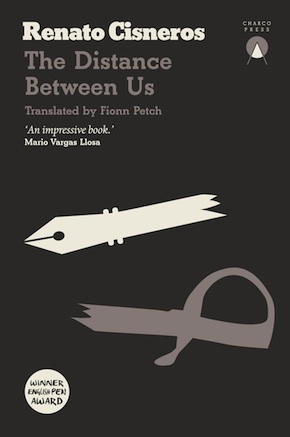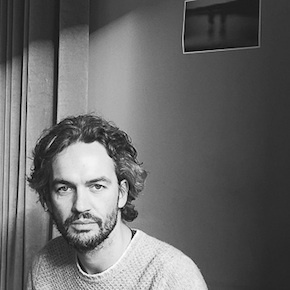Uncertain regard
by Fionn Petch
“This is an impressive book. In writing it the author demonstrates great talent, as well as great courage.” Mario Vargas Llosa
There is a point in his novel The Distance Between Us at which Renato Cisneros describes his father’s obsession with watching the TV news, and his own ineffectual attempts as a child to compete for his attention. In passing, he speculates that his entire subsequent career as a journalist and TV presenter could be seen as an attempt to address his father from “the other side of the glass screen”, in a way that “would at last hold his attention”. Except that his father died when Renato was 18 years old, and would never see the person he became: a hugely successful writer and media personality. Nevertheless, this brief remark seems to me the most poignant expression of the novel’s overarching theme: how the actions and omissions of our parents – in this case an authoritarian father more concerned with his public image as a military man and a government minister than with his children’s futures – shape our future selves, both actively and reactively. How each new generation tries to amend for the failings of the one before, even as their own characters are defined by it. This is something any reader can relate to, even if their father does not happen to have been a leading figure in the Peruvian dictatorships of the 1970s, an egotistical bully, and an incorrigible controversialist, incessantly plotting military coups even long after he had retired.
Since Renato Cisneros never knew his father as an adult, his view of him was very partial: not only with regard to his public reputation, but also his multiple personas and the many family secrets buried in his past, secrets that perhaps explain why he became the distant, intransigent man he was, and how he became an apologist for – perhaps even a perpetrator of – acts of bloody repression that had ramifications across Latin America. The Distance Between Us follows Renato as he unravels these secrets. The story is not told from a position of omniscience, of distant and serene reflection: instead, we track the author in tight focus as he grapples with the emotions his successive discoveries and recollections evoke. As a result, the writing itself is sometimes tentative, hesitant. A frequent stylistic tic, for example, is to offer a cluster of three slightly contrasting verbs or adjectives, as if asking the reader to choose between them. One of the challenges as translator of the book was to maintain this sense of self-doubt about the quest the author is undertaking without it seeming unnatural or forced in English, a language where the risk of slipping into a maudlin tone is greater. At other moments, achieving the impact of a relentless, breathless section of narration necessitated breaking down two-page-long sentences into dozens of shorter ones. What is considered an acceptable narrative technique in Spanish sometimes has to find a different form in English to achieve the same end.
Translation happens at a very different speed to reading… A certain distance from the text is required to allow you to experience it again as a reader.”
There are points at which the work of the author and the translator overlap, and others where they diverge. The translator need not worry, for example, about what the characters are going to do next. One thing that does perhaps replicate the experience of the author is the doubts that arise when you are deeply engaged in the process (and this is, above all, a book about doubt.) Translation happens at a very different speed to reading, and as a translator you doubt, among other things, your ability to calibrate the final text so that it achieves the same velocity as the original. A certain distance from the text is required to allow you to experience it again as a reader. During the early drafts there are periods of getting bogged down in the word-by-word of seemingly endless paragraphs, and you wonder how the text will be anything but plodding. But then you come back to it after a break and find that it flies. This is one of the joys of translation. You understand that, as a reader, there are certain kinds of books where you skip down the lines, drinking it all in. The task of the translator is to enable the new reader to skip in the same way: and working out how to achieve this also offers a lot of insight into how a novel is constructed.
The uncertain status of the narration in The Distance Between Us makes the translator’s work doubly difficult when it comes to fact-checking. Even as Renato is trying to lay bare the truth of his father’s life, he is inventing dialogue, imagining encounters, changing people’s names, synthesising several real historical figures into one fictional character. As he puts it: “it’s a novel conscious of the fact that reality occurs only once… and any reproduction is condemned to adulteration, to distortion, to simulacrum.” But when a novel is set in the real world, it is part of the translator’s job to check historical and geographical references, and in general to immerse yourself in the setting and the culture of the novel. This is another of the joys of translating with the tools available today. You can travel with your author on Google Street View as he tramps the avenues of Buenos Aires in search of the house his father grew up in, and gaze at its apparently unchanged facade. You can drive up the boulevard in Lima where his father’s mistress crossed paths with his family coming in the opposite direction in their green Malibu. And then, as you carry on along the Pacific coastal highway, you can come to realise why the sea is always described in the book as turbulent, dark and treacherous – because that is what the ocean is often like in Peru. Understanding the world through the author’s eyes is a vital skill as a translator. At one point, I was stumped at Renato’s description of the Argentinian General Jorge Videla as having “passion fruit-coloured” eyes. Passion fruit can have orange or purple skin, and however much I zoomed in to photos of the murderous dictator online I was still puzzled. Before firing off a query to the author I posted my dilemma on Twitter, as an example of the strange research activities translators get up to, and it was swiftly resolved by a Peruvian colleague who pointed out that – of course – it refers to the seeds of the passion fruit, to the part you actually eat, which are blue-grey. An object lesson in ‘sitting down to eat’ with your author.
Sitting down to eat with my author was also something I was tempted to do literally: so often in the book Renato refers to his own physical stature and his sense that he “never had a defined way of being” in comparison to his father, that part way through the translation process I was seized by an urge to meet him in person, not necessarily to talk about the book but to observe how he moves, his bearing, how he holds his knife and fork, how he laughs. To see or imagine for myself the traces of the father in the son. Yet in the end it wasn’t possible. And that is probably for the better. I might have felt inhibited by him stepping off the page, out of the uncertain realm he inhabits here between fiction and reality. Now that I have relinquished control over the book I am very much looking forward to meeting him, as I feel I have been living inside his head for the best part of a year. I hope readers find it as interesting and moving a place to spend time as I have.
 Renato Cisneros, born in Lima in 1976, is a well-known journalist, broadcaster and writer. Having published a number of books of poetry and two novels, in 2015 he stepped back from his career as a broadcaster to fully concentrate on his writing, and he is now based in Madrid. The Distance Between Us, translated by Fionn Petch, is published by Charco Press. It was shortlisted for the Second Mario Vargas Llosa Biannual Award, longlisted for the Prix Médicis (2017) and the winner of the Prix Transfuge du Meilleur Roman de Littérature Hispanique (2017). A prequel, Dejarás la tierra is already a bestseller in Spain and Latin America.
Renato Cisneros, born in Lima in 1976, is a well-known journalist, broadcaster and writer. Having published a number of books of poetry and two novels, in 2015 he stepped back from his career as a broadcaster to fully concentrate on his writing, and he is now based in Madrid. The Distance Between Us, translated by Fionn Petch, is published by Charco Press. It was shortlisted for the Second Mario Vargas Llosa Biannual Award, longlisted for the Prix Médicis (2017) and the winner of the Prix Transfuge du Meilleur Roman de Littérature Hispanique (2017). A prequel, Dejarás la tierra is already a bestseller in Spain and Latin America.
Read more
@recisneros
Author portrait © Alfonso Vargas Saitua
 Fionn Petch was born in Scotland, lived in Mexico City for twelve years, and is now based in Berlin. He translates fiction, poetry and plays from Spanish and French, and also specialises in books and exhibition catalogues on art and architecture. He holds a doctorate in philosophy from the National University of Mexico (UNAM), on the concept of persuasion in early Greek thought.
Fionn Petch was born in Scotland, lived in Mexico City for twelve years, and is now based in Berlin. He translates fiction, poetry and plays from Spanish and French, and also specialises in books and exhibition catalogues on art and architecture. He holds a doctorate in philosophy from the National University of Mexico (UNAM), on the concept of persuasion in early Greek thought.
elusiveword.com
@elusiveword

